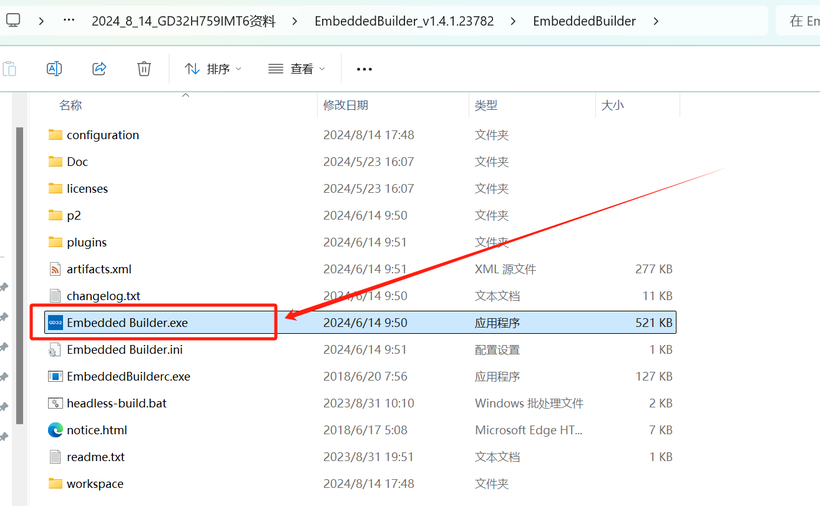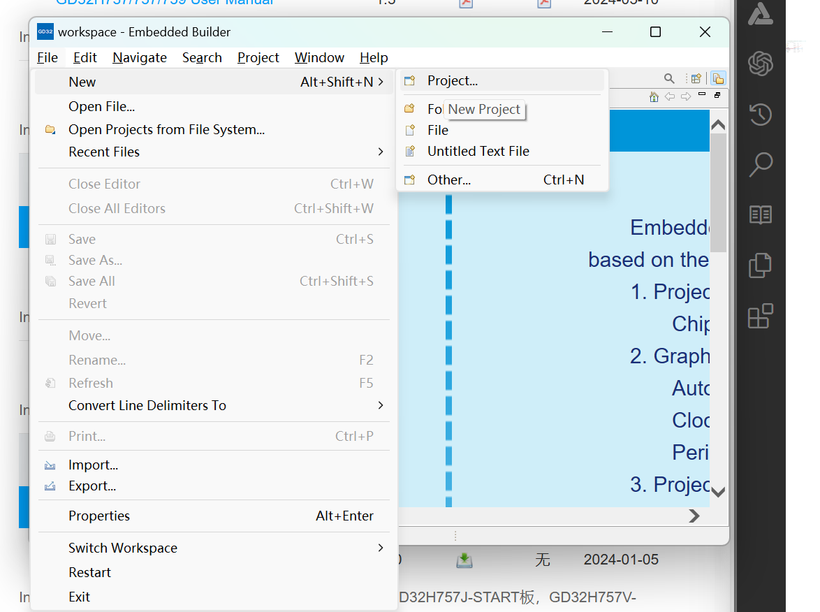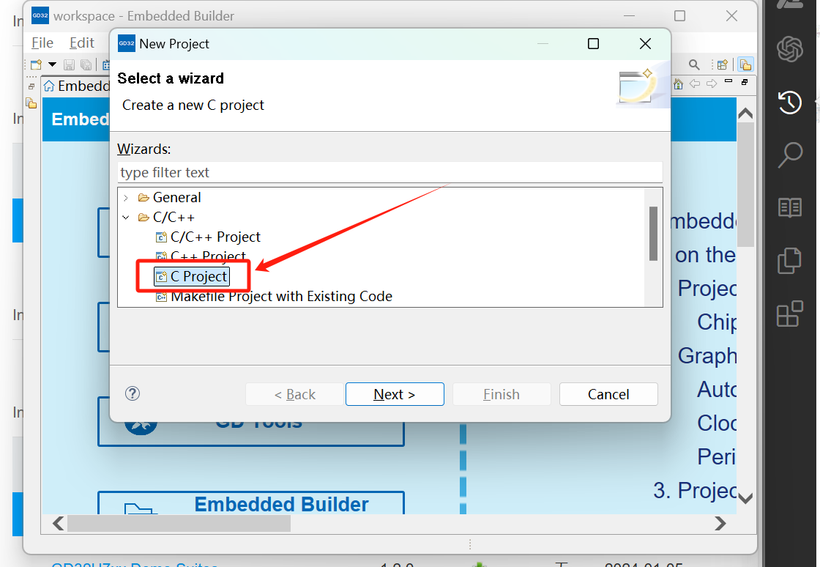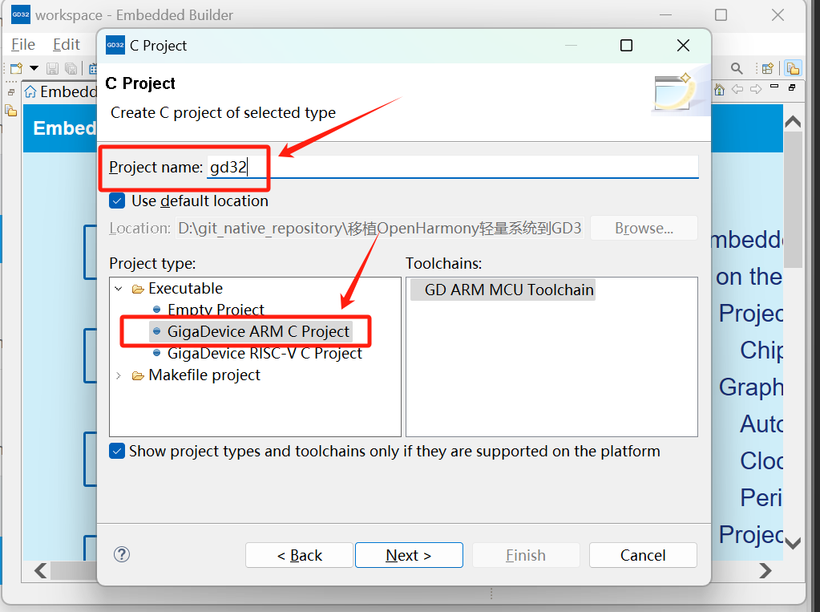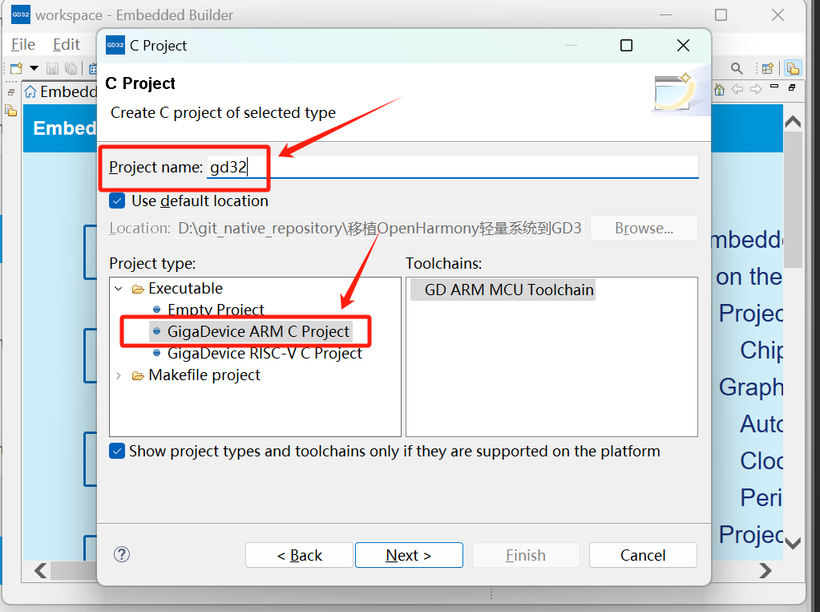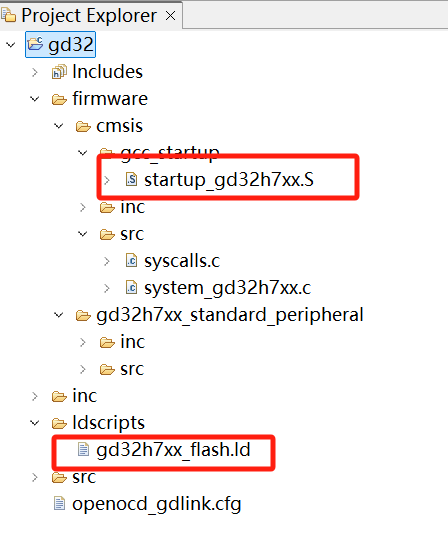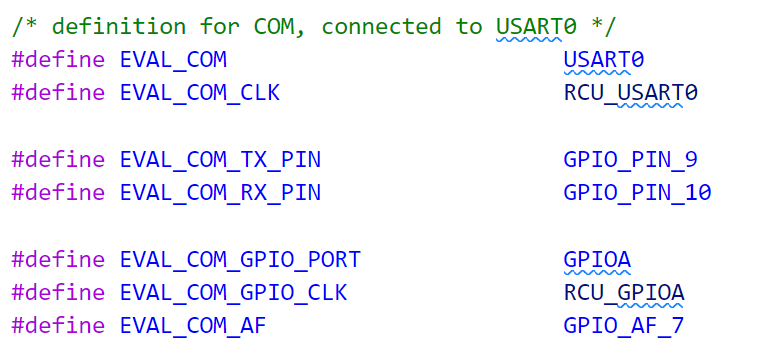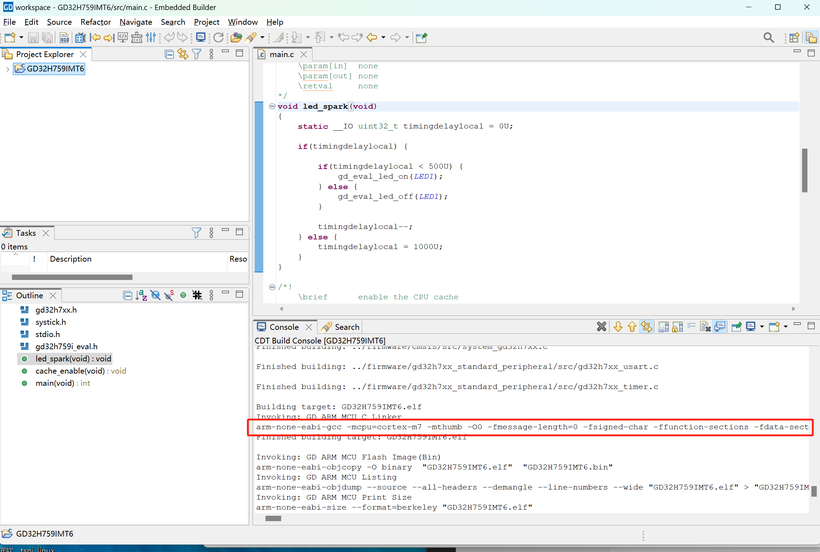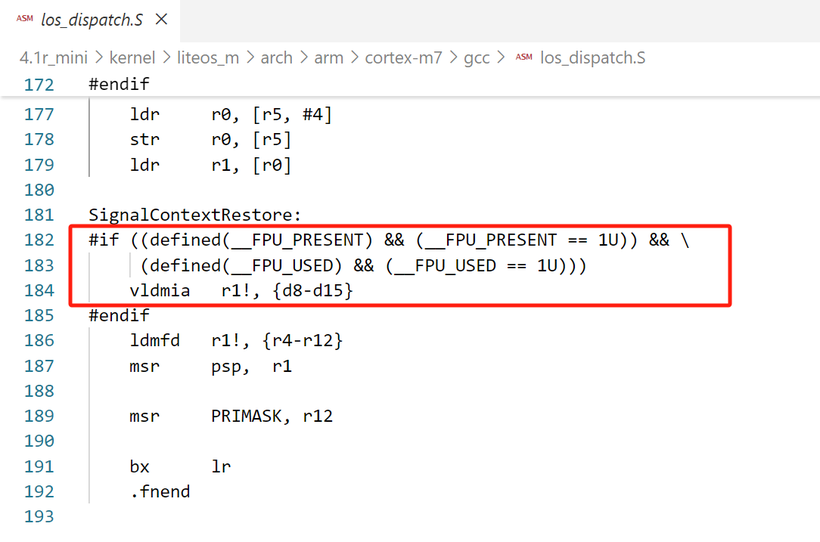笔者利用国庆假期的时间适配了一款Cortex-M7 的国产厂商兆易创新GD32H459,开源地址:https://gitee.com/GD32H759_OpenHarmony
OpenHarmony 4.1r 轻量系统移植到GD32H759文档
1.学习本文档的意义
1.学习如何移植OpenHarmony轻量系统4.1r到GD32 m7内核GD32H737/GD32H757/GD32H759系列MCU上。
2.本文档移植的具体型号为GD32H759IMT6,采用的开发板是慧勤智远GD32H759IMT6开发板
2.学习OpenHarmony轻量系统开发
1.移植之前必须要先熟悉慧勤智远GD32H759IMT6开发板的使用,了解板子的裸机编程、板子裸机工程的默认调试串口。
2.获取到GD32H759IMT6的底层驱动源代码(Firmware Library)
2.0 熟悉GD32H759IMT6的裸机开发
1.兆易创新提供了官方的开发工具GD32 Embedded Builder,下载地址:https://www.gd32mcu.com/cn/download/0?kw=GD32H7
2.解压直接打开(免安装)
3.新建C工程
4.选择arm工程
5.选择GD32H759系列芯片GD32H759IMT6
6.此时就可以看到GD32H759IMT6的驱动库、ld链接文件和.s文件
7.简单点个灯
8.调试串口,PA9和PA10两个GPIO口
2.1 安装源码对应的hb工具
使用什么版本的OpenHarmony的源码,就安装此版本源码对应的hb工具
前提条件
Linux服务器,Ubuntu16.04及以上64位系统版本。
Python 3.7.4及以上。
源码下载成功。
安装hb
在源码根目录下执行:
python3 -m pip install --user build/hb
执行hb help有相关帮助信息,有打印信息即表示安装成功,当前hb 主要提供了hb set,hb build,hb tool,hb env,hb clean五个选项。卸载方法:
python3 -m pip uninstall ohos-build
3.轻量系统GD32H759IMT6芯片移植案例
3.1 目录规划
GD32H759IMT6基于Cortex-M7,移植架构采用Board与SoC分离方案,使用arm-none-eabi-gcc工具链(在轻量系统源码中可以指定编译工具链路径,具体可以查看 https://gitee.com/AT32437_OpenHarmony/arm-gnu-toolchain-12.3.rel1-x86_64-arm-none-eabi)
芯片适配目录规划为:
device
├── board --- 单板厂商目录
│ └── gigadevice_board --- 单板厂商名字:兆易创新
└── soc --- SoC厂商目录
└── gigadevice --- SoC厂商名称
└── gd32h7xx --- SoC Series名
产品样例目录规划为:
vendor
└── gigadevice --- 开发产品样例厂商目录
└── GD32H759IMT6_BOARD --- 产品名字:GD32H759IMT6_BOARD
3.2 预编译适配
预编译适配内容就是围绕hb set命令的适配,使工程能够通过该命令设置根目录、单板目录、产品目录、单板公司名等环境变量,为后续适配编译做准备。
具体的预编译适配步骤如下:
1.在vendor\gigadevice\GD32H759IMT6_BOARD\目录下新增config.json文件,用于描述这个产品样例所使用的单板、内核等信息,描述信息可参考如下内容:
{
"product_name": "GD32H759IMT6_BOARD", --- 用于hb set进行选择时,显示的产品名称
"ohos_version": "OpenHarmony 4.1",
"type": "mini", --- 构建系统的类型,mini/small/standard
"version": "3.0", --- 构建系统的版本,1.0/2.0/3.0
"device_company": "gigadevice_board", --- 单板厂商名,用于编译时找到device\board\gigadevice_board目录
"board": "atstartf437", --- 单板名,用于编译时找到device\board\gigadevice_board\gd32h759目录
"kernel_type": "liteos_m", --- 内核类型,因为OpenHarmony支持多内核,一块单板可能适配了多个内核,所以需要指定某个内核进行编译
"kernel_version": "3.0.0", --- 内核版本,一块单板可能适配了多个linux内核版本,所以需要指定某个具体的内核版本进行编译
"subsystems": [ ] --- 选择所需要编译构建的子系统
}
2.在device\board\gigadevice_board\gd32h759\liteos_m目录下新增一个config.gni文件,用于描述该产品的编译配置信息,内核配置为m7
# Kernel type, e.g. "linux", "liteos_a", "liteos_m".
kernel_type = "liteos_m"
# Kernel version.
kernel_version = "3.0.0"
# Board CPU type, e.g. "cortex-a7", "riscv32".
# GD32H759IMT6
board_cpu = "cortex-m7"
3.3 添加GD32H759IMT6驱动库
把原厂的驱动文件放置在device\soc\gigadevice\gd32h7xx\libraries和device\soc\gigadevice\gd32h7xx\liteos_m目录下面,为了消除编译报错需要进行一些修改
1.device/soc/artery/at32f4xx/libraries/drivers/inc/gd32h7xx_timer.h中INVALID修改为GD32H759IMT6_INVALID,规避重定义问题
/* constants definitions */
/* UPIFBU bit state */
/*GD32H759IMT6*/
typedef enum {VALID_RESET = 0, VALID_SET = 1, GD32H759IMT6_INVALID = 2} UPIFBUStatus;
2.device/soc/artery/at32f4xx/libraries/drivers/src/gd32h7xx_timer.c中INVALID修改为GD32H759IMT6_INVALID,规避重定义问题
/*!
\brief get the UPIFBU bit in the TIMERx_CNT register
\param[in] timer_periph: TIMERx(x=0~7,14~16,22,23,30,31,40~44,50,51)
\param[out] none
\retval UPIFBUStatus: VALID_SET or VALID_RESET or GD32H759IMT6_INVALID
\ret VALID_SET: the UPIFBU is valid and value is 1
\ret VALID_RESET: the UPIFBU is valid and value is 0
\ret GD32H759IMT6_INVALID: the UPIFBU is invalid
*/
UPIFBUStatus timer_upifbu_bit_get(uint32_t timer_periph)
{
if((TIMER_CTL0(timer_periph) & TIMER_CTL0_UPIFBUEN)) {
if((TIMER50 == timer_periph) || (TIMER51 == timer_periph)) {
if(TIMER_CNTH(timer_periph) & TIMER_CNT_UPIFBU) {
return VALID_SET;
} else {
return VALID_RESET;
}
} else {
if(TIMER_CNT(timer_periph) & TIMER_CNT_UPIFBU) {
return VALID_SET;
} else {
return VALID_RESET;
}
}
} else {
return GD32H759IMT6_INVALID;
}
}
3.4 修改.ld文件
GD32H759IMT6是链接脚本gd32h7xx_flash.ld,适配OpenHarmony轻量系统需要做以下修改,具体修改对比请查看GD32H759IMT6适配OpenHarmony轻量系统前后gd32h7xx_flash
1.注释GROUP(libgcc.a libc.a libm.a libnosys.a),取消libgcc.a libc.a libm.a libnosys.a的引用
3.5 在config.gni添加编译时需要的cflag和LDFLAGS
1.前面提到了兆易创新提供了开发工具GD32 Embedded Builder,需要从中提取编译时需要添加的编译标志,如下图所示
arm-none-eabi-gcc -mcpu=cortex-m7 -mthumb -O0 -fmessage-length=0 -fsigned-char -ffunction-sections -fdata-sections -g3 -Wl,-Map,"GD32H759IMT6.map" -T gd32h7xx_flash.ld -Xlinker --gc-sections -L"../ldscripts" -Xlinker --cref --specs=nano.specs -u_printf_float --specs=nosys.specs -o "GD32H759IMT6.elf" ./src/gd32h759i_eval.o ./src/gd32h7xx_it.o ./src/main.o ./src/systick.o ./firmware/gd32h7xx_standard_peripheral/src/gd32h7xx_adc.o ./firmware/gd32h7xx_standard_peripheral/src/gd32h7xx_can.o ./firmware/gd32h7xx_standard_peripheral/src/gd32h7xx_cau.o ./firmware/gd32h7xx_standard_peripheral/src/gd32h7xx_cau_aes.o ./firmware/gd32h7xx_standard_peripheral/src/gd32h7xx_cau_des.o ./firmware/gd32h7xx_standard_peripheral/src/gd32h7xx_cau_tdes.o ./firmware/gd32h7xx_standard_peripheral/src/gd32h7xx_cmp.o ./firmware/gd32h7xx_standard_peripheral/src/gd32h7xx_cpdm.o ./firmware/gd32h7xx_standard_peripheral/src/gd32h7xx_crc.o ./firmware/gd32h7xx_standard_peripheral/src/gd32h7xx_ctc.o ./firmware/gd32h7xx_standard_peripheral/src/gd32h7xx_dac.o ./firmware/gd32h7xx_standard_peripheral/src/gd32h7xx_dbg.o ./firmware/gd32h7xx_standard_peripheral/src/gd32h7xx_dci.o ./firmware/gd32h7xx_standard_peripheral/src/gd32h7xx_dma.o ./firmware/gd32h7xx_standard_peripheral/src/gd32h7xx_edout.o ./firmware/gd32h7xx_standard_peripheral/src/gd32h7xx_efuse.o ./firmware/gd32h7xx_standard_peripheral/src/gd32h7xx_enet.o ./firmware/gd32h7xx_standard_peripheral/src/gd32h7xx_exmc.o ./firmware/gd32h7xx_standard_peripheral/src/gd32h7xx_exti.o ./firmware/gd32h7xx_standard_peripheral/src/gd32h7xx_fac.o ./firmware/gd32h7xx_standard_peripheral/src/gd32h7xx_fmc.o ./firmware/gd32h7xx_standard_peripheral/src/gd32h7xx_fwdgt.o ./firmware/gd32h7xx_standard_peripheral/src/gd32h7xx_gpio.o ./firmware/gd32h7xx_standard_peripheral/src/gd32h7xx_hau.o ./firmware/gd32h7xx_standard_peripheral/src/gd32h7xx_hau_sha_md5.o ./firmware/gd32h7xx_standard_peripheral/src/gd32h7xx_hpdf.o ./firmware/gd32h7xx_standard_peripheral/src/gd32h7xx_hwsem.o ./firmware/gd32h7xx_standard_peripheral/src/gd32h7xx_i2c.o ./firmware/gd32h7xx_standard_peripheral/src/gd32h7xx_ipa.o ./firmware/gd32h7xx_standard_peripheral/src/gd32h7xx_lpdts.o ./firmware/gd32h7xx_standard_peripheral/src/gd32h7xx_mdio.o ./firmware/gd32h7xx_standard_peripheral/src/gd32h7xx_mdma.o ./firmware/gd32h7xx_standard_peripheral/src/gd32h7xx_misc.o ./firmware/gd32h7xx_standard_peripheral/src/gd32h7xx_ospi.o ./firmware/gd32h7xx_standard_peripheral/src/gd32h7xx_ospim.o ./firmware/gd32h7xx_standard_peripheral/src/gd32h7xx_pmu.o ./firmware/gd32h7xx_standard_peripheral/src/gd32h7xx_rameccmu.o ./firmware/gd32h7xx_standard_peripheral/src/gd32h7xx_rcu.o ./firmware/gd32h7xx_standard_peripheral/src/gd32h7xx_rspdif.o ./firmware/gd32h7xx_standard_peripheral/src/gd32h7xx_rtc.o ./firmware/gd32h7xx_standard_peripheral/src/gd32h7xx_rtdec.o ./firmware/gd32h7xx_standard_peripheral/src/gd32h7xx_sai.o ./firmware/gd32h7xx_standard_peripheral/src/gd32h7xx_sdio.o ./firmware/gd32h7xx_standard_peripheral/src/gd32h7xx_spi.o ./firmware/gd32h7xx_standard_peripheral/src/gd32h7xx_syscfg.o ./firmware/gd32h7xx_standard_peripheral/src/gd32h7xx_timer.o ./firmware/gd32h7xx_standard_peripheral/src/gd32h7xx_tli.o ./firmware/gd32h7xx_standard_peripheral/src/gd32h7xx_tmu.o ./firmware/gd32h7xx_standard_peripheral/src/gd32h7xx_trigsel.o ./firmware/gd32h7xx_standard_peripheral/src/gd32h7xx_trng.o ./firmware/gd32h7xx_standard_peripheral/src/gd32h7xx_usart.o ./firmware/gd32h7xx_standard_peripheral/src/gd32h7xx_vref.o ./firmware/gd32h7xx_standard_peripheral/src/gd32h7xx_wwdgt.o ./firmware/cmsis/src/syscalls.o ./firmware/cmsis/src/system_gd32h7xx.o ./firmware/cmsis/gcc_startup/startup_gd32h7xx.o
2.还需要添加MCU宏GD32H7XX,USE_STDPERIPH_DRIVER
3.6 Cortex-M7的MCU和Cortex-M4适配Liteos-m的不同——fpu适配
适配Cortex-M7的GD32H759IMT6时,需要在config.gni的board_cflags中添加-D__FPU_PRESENT=1U``-D__FPU_USED=1U,并且需要在gd32h7xx.h中注释掉__FPU_PRESENT。
OpenHarmony轻量系统源码kernel/liteos_m/arch/arm/cortex-m7/gcc/los_dispatch.S中需要同时定义__FPU_PRESENT=1U和__FPU_USED=1U,fpu才能添加进编译
相关issues:https://gitee.com/openharmony/kernel_liteos_m/issues/I4D575?from=project-issue
3.7 修改.s文件,并且LiteOS-M接管外部GD32H759IMT6中断
startup_gd32h7xx.S中继续使用GD32H759IMT6原生的中断处理函数
.word SysTick_Handler /*使用GD32H759IMT6原生的中断处理函数*/
然后在target_config.h的LOSCFG_PLATFORM_HWI和LOSCFG_USE_SYSTEM_DEFINED_INTERRUPT定义为1。表明LiteOS-M接管了GD32H759IMT6的中断

